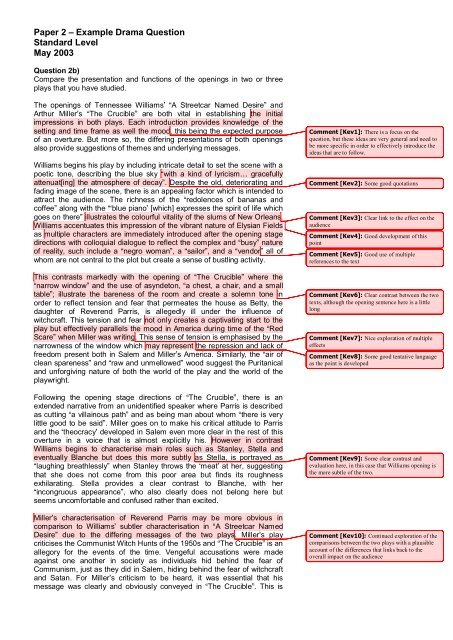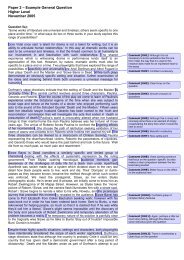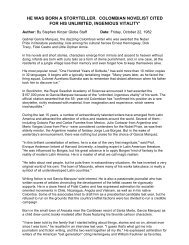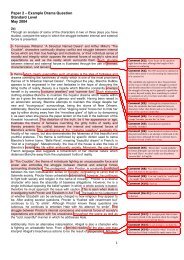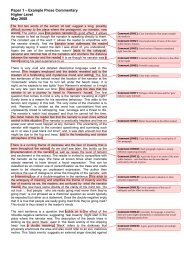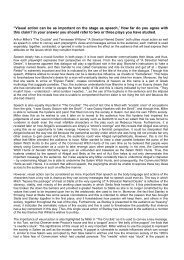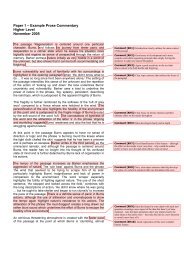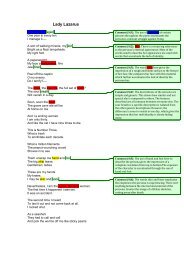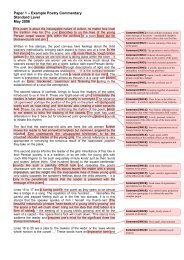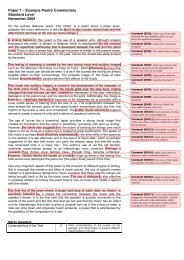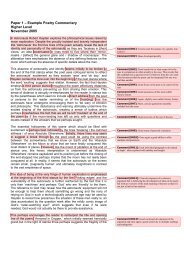The Role of Openings - Mr Hoye's IB English Website
The Role of Openings - Mr Hoye's IB English Website
The Role of Openings - Mr Hoye's IB English Website
- No tags were found...
You also want an ePaper? Increase the reach of your titles
YUMPU automatically turns print PDFs into web optimized ePapers that Google loves.
Paper 2 – Example Drama QuestionStandard LevelMay 2003Question 2b)Compare the presentation and functions <strong>of</strong> the openings in two or threeplays that you have studied.<strong>The</strong> openings <strong>of</strong> Tennessee Williams A Streetcar Named Desire andArthur Millers <strong>The</strong> Crucible are both vital in establishing the initialimpressions in both plays. Each introduction provides knowledge <strong>of</strong> thesetting and time frame as well the mood, this being the expected purpose<strong>of</strong> an overture. But more so, the differing presentations <strong>of</strong> both openingsalso provide suggestions <strong>of</strong> themes and underlying messages.Williams begins his play by including intricate detail to set the scene with apoetic tone, describing the blue sky with a kind <strong>of</strong> lyricism gracefullyattenuat[ing] the atmosphere <strong>of</strong> decay. Despite the old, deteriorating andfading image <strong>of</strong> the scene, there is an appealing factor which is intended toattract the audience. <strong>The</strong> richness <strong>of</strong> the redolences <strong>of</strong> bananas andc<strong>of</strong>fee along with the blue piano [which] expresses the spirit <strong>of</strong> life whichgoes on there illustrates the colourful vitality <strong>of</strong> the slums <strong>of</strong> New Orleans.Williams accentuates this impression <strong>of</strong> the vibrant nature <strong>of</strong> Elysian Fieldsas multiple characters are immediately introduced after the opening stagedirections with colloquial dialogue to reflect the complex and busy nature<strong>of</strong> reality, such include a negro woman, a sailor, and a vendor all <strong>of</strong>whom are not central to the plot but create a sense <strong>of</strong> bustling activity.This contrasts markedly with the opening <strong>of</strong> <strong>The</strong> Crucible where thenarrow window and the use <strong>of</strong> asyndeton, a chest, a chair, and a smalltable; illustrate the bareness <strong>of</strong> the room and create a solemn tone inorder to reflect tension and fear that permeates the house as Betty, thedaughter <strong>of</strong> Reverend Parris, is allegedly ill under the influence <strong>of</strong>witchcraft. This tension and fear not only creates a captivating start to theplay but effectively parallels the mood in America during time <strong>of</strong> the RedScare when Miller was writing. This sense <strong>of</strong> tension is emphasised by thenarrowness <strong>of</strong> the window which may represent the repression and lack <strong>of</strong>freedom present both in Salem and Millers America. Similarly, the air <strong>of</strong>clean spareness and raw and unmellowed wood suggest the Puritanicaland unforgiving nature <strong>of</strong> both the world <strong>of</strong> the play and the world <strong>of</strong> theplaywright.Following the opening stage directions <strong>of</strong> <strong>The</strong> Crucible, there is anextended narrative from an unidentified speaker where Parris is describedas cutting a villainous path and as being man about whom there is verylittle good to be said. Miller goes on to make his critical attitude to Parrisand the theocracy developed in Salem even more clear in the rest <strong>of</strong> thisoverture in a voice that is almost explicitly his. However in contrastWilliams begins to characterise main roles such as Stanley, Stella andeventually Blanche but does this more subtly as Stella, is portrayed aslaughing breathlessly when Stanley throws the meat at her, suggestingthat she does not come from this poor area but finds its roughnessexhilarating. Stella provides a clear contrast to Blanche, with herincongruous appearance, who also clearly does not belong here butseems uncomfortable and confused rather than excited.Millers characterisation <strong>of</strong> Reverend Parris may be more obvious incomparison to Williams subtler characterisation in A Streetcar NamedDesire due to the differing messages <strong>of</strong> the two plays. Millers playcriticises the Communist Witch Hunts <strong>of</strong> the 1950s and <strong>The</strong> Crucible is anallegory for the events <strong>of</strong> the time. Vengeful accusations were madeagainst one another in society as individuals hid behind the fear <strong>of</strong>Communism, just as they did in Salem, hiding behind the fear <strong>of</strong> witchcraftand Satan. For Millers criticism to be heard, it was essential that hismessage was clearly and obviously conveyed in <strong>The</strong> Crucible. This isComment [Kev1]: <strong>The</strong>re is a focus on thequestion, but these ideas are very general and need tobe more specific in order to effectively introduce theideas that are to follow.Comment [Kev2]: Some good quotationsComment [Kev3]: Clear link to the effect on theaudienceComment [Kev4]: Good development <strong>of</strong> thispointComment [Kev5]: Good use <strong>of</strong> multiplereferences to the textComment [Kev6]: Clear contrast between the twotexts, although the opening sentence here is a littlelongComment [Kev7]: Nice exploration <strong>of</strong> multipleeffectsComment [Kev8]: Some good tentative languageas the point is developedComment [Kev9]: Some clear contrast andevaluation here, in this case that Williams opening isthe more subtle <strong>of</strong> the two.Comment [Kev10]: Continued exploration <strong>of</strong> thecomparisons between the two plays with a plausibleaccount <strong>of</strong> the differences that links back to theoverall impact on the audience


